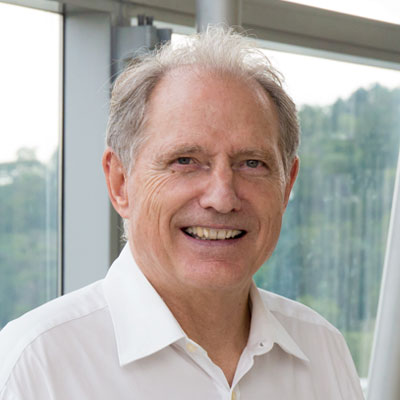Jacques PROST
Visiting Faculty, Distinguished Professor, Mechanobiology Institute, National University of Singapore, Emeritus Professor, Institut Curie
Research Program
Physical Approach of Biological Problems
Affiliations
Emeritus Professor, Institut Curie
Jacques Prost
Visiting Faculty, Distinguished Professor
Research Areas
Physical Approach of Biological Problems
Research Interests
A rapid inspection of orders of magnitude involved in cell components show that they are very similar to those relevant to “Soft Matter Physics”. There are however two important differences: biological systems are clearly out of equilibrium and molecular specificity can be strongly relevant. These simple remarks convince us that on the one hand Soft Matter Physics can provide a quantitative description of cellular systems, and that on the other hand biological systems raise an interesting number of new and challenging physical questions.
For these reasons we concentrate our efforts towards understanding physical features of cell morphology and dynamics. This project is meaningful only with strong interactions with biologists.
Cells contain a very large number of components, but if we focus on mechanical properties, only a few classes of component are relevant: the cytoskeletal networks, molecular motors, phospholipid membranes and the large class of adhesion molecules such as integrins or cadherins. Therefore we study each of these components, keeping in mind the importance of the non-equilibrium behavior. In some cases, this requires the introduction of new physical concepts such as “active” membranes, “active” gels or “isothermal ratchet”, which is a model to describe molecular motors by the Brownian motion of a particle switching between two different states. Read more about Docteur Jacques Prost’s group and research
Biography
Prof Prost is emeritus CNRS research director at the Curie Institute in Paris, and distinguished visiting professor at NUS.
After developing a research activity on Soft Condensed Matter and Statistical Physics with a strong emphasis on Liquid Crystals, he has been interested in the physics-biology interface. In particular, he has been active in the description of molecular motors, hearing, cell and tissue dynamics for which he introduced the concept of “active gels” and that of homeostatic pressure for tissues.
He was successively at the origin of the “Bordeaux Liquid Crystal Group”, of the “Laboratory of Theoretical Physical Chemistry” at ESPCI (Paris) and of the “Physical Chemistry Laboratory” at the Curie Institute (Paris).
He is a member of the French and European Academy of Sciences and has been awarded the 2007 Del Duca European Grand Prix and 2016 Beverly and Raymond Sackler prize in Biophysics.
Recent MBI Publications
- Shi W, Duclut C, Xu Y, Ma Y, Qiao J, Lin B, Yang D, Prost J, and Dong B. Physics of notochord tube expansion in ascidians. Proc Natl Acad Sci U S A 2025; 122(23):e2419960122. [PMID: 40472029]
- Lin S, Prost J, and Rupprecht J. Curvature-induced clustering of cell adhesion proteins. Phys Rev E 2024; 109(5-1):054406. [PMID: 38907394]
- Lin S, Changede R, Farrugia AJ, Bershadsky AD, Sheetz MP, Prost J, and Rupprecht J. Membrane Tilt Drives Phase Separation of Adhesion Receptors. Phys Rev Lett 2024; 132(18):188402. [PMID: 38759206]
- Das R, Sakaue T, Shivashankar GV, Prost J, and Hiraiwa T. Chromatin Remodeling Due to Transient-Link-and-Pass Activity Enhances Subnuclear Dynamics. Phys Rev Lett 2024; 132(5):058401. [PMID: 38364140]
- Prasad M, Obana N, Lin S, Zhao S, Sakai K, Blanch-Mercader C, Prost J, Nomura N, Rupprecht J, Fattaccioli J, and Utada AS. Alcanivorax borkumensis biofilms enhance oil degradation by interfacial tubulation. Science 2023; 381(6659):748-753. [PMID: 37590351]
- Kawaue T, Yow I, Pan Y, Le AP, Lou Y, Loberas M, Shagirov M, Teng X, Prost J, Hiraiwa T, Ladoux B, and Toyama Y. Inhomogeneous mechanotransduction defines the spatial pattern of apoptosis-induced compensatory proliferation. Dev Cell 2023;. [PMID: 36800994]
- Sonam S, Balasubramaniam L, Lin S, Ivan YMY, Jaumà IP, Jebane C, Karnat M, Toyama Y, Marcq P, Prost J, Mège R, Rupprecht J, and Ladoux B. Mechanical stress driven by rigidity sensing governs epithelial stability. Nat Phys 2022; 19:132-141. [PMID: 36686215]
- Jülicher F, Prost J, and Toner J. Broken living layers: Dislocations in active smectic liquid crystals. Phys Rev E 2022; 106(5-1):054607. [PMID: 36559431]
- Das R, Sakaue T, Shivashankar GV, Prost J, and Hiraiwa T. How enzymatic activity is involved in chromatin organization. Elife 2022; 11. [PMID: 36472500]
- Bell S, Lin S, Rupprecht J, and Prost J. Active Nematic Flows over Curved Surfaces. Phys Rev Lett 2022; 129(11):118001. [PMID: 36154433]
Recent Publications
- Prost Jacques, Jülicher Frank, Joanny Jean-François, “Active gels Physics”, NATURE PHYSICS, vol 11, Pages 11-117, Published Feb (2015)
- Datar A, Bornschlögl T, Bassereau P, Prost J, Pullarkat P, Dynamics of Membrane Tethers Reveal Novel Aspects of Cytoskeleton-Membrane Interactions in Axons, Biophysical Journal, 108, 489-497(2015)
- Risler T, Peilloux A, Prost J, « Homeostatic fluctuations of a Tissue surface », Phys.Rev.Lett., 115 :258104 (2015).
- Marbach S, Godeau A L, Riveline D, Joanny J F, Prost J, « Theoretical study of actin layer attachment and separation”, The European Physical Journal E, Nov 38:122 (2015)
- Sekimoto K, Prost J, “Elastic Anisotropy Scenario for Cooperative binding of Kinesin-Coated Beads on Microtubules”, J Phys Chem B, 2016; 120(26):5953-9. [PMID: 27027685]
- Rupprecht J, and Prost J. PHYSICAL BIOLOGY. A fresh eye on nonequilibrium systems. Science 2016; 352(6285):514-5. [PMID: 27126022]
- ME Dolega, M Delarue, F Ingremeau, J Prost, A Delon, G Cappello, “Cell-like pressure sensors reveal increase of mechanical stress towards the core of multicellular spheroids under compression”, Nature Communications, Jan, 8, (2017)
- Simunovic M, Manneville J B, Renard H F, Evergren E, Raghunathan, K, Bhatia D, Kenworthy A, Vith G, Prost J, McMahon H, Johannes L, Bassereau P, Callan-Jones A, “Friction mediates Scission of membrane nanotubes scaffolded by BAR proteins” (2017) accepted CELL-D-2131-R3



